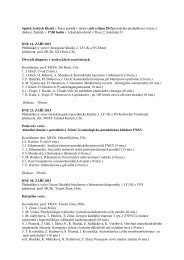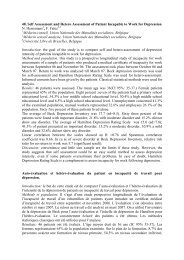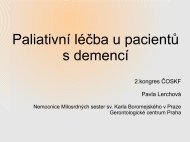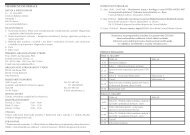ABSTRACTS â ORAL PRESENTATIONS - AMCA, spol. s r.o.
ABSTRACTS â ORAL PRESENTATIONS - AMCA, spol. s r.o.
ABSTRACTS â ORAL PRESENTATIONS - AMCA, spol. s r.o.
Create successful ePaper yourself
Turn your PDF publications into a flip-book with our unique Google optimized e-Paper software.
P82. FLOW CYTOMETRIC ANALYSIS AND MULTIPLE LINEAGE DIFFERENTIATION OF<br />
ADIPOSE TISSUE-DERIVED STEM CELLS OF DIABETIC PATIENTS<br />
Kollárová Z. 1,2 Kubinová Š. 1,2 , Turnovcová K. 1,2 , Syková E. 1<br />
kollarova@biomed.cas.cz<br />
1<br />
Institute of Experimental Medicine ASCR, Prague, Czech Republic<br />
2<br />
2 nd Faculty of Medicine, Charles University, Prague, Czech Republic<br />
INTRODUCTION<br />
Adipose tissue is an abundant source of autologous adult stem cells that may open<br />
new therapeutic perspectives for the treatment of type I. and type II. diabetes and<br />
their complications. However, it is unclear whether the mesenchymal stem cells of<br />
diabetic patients, constantly influenced by hyperglycaemia, have the same properties as<br />
mesenchymal stem cells from non-diabetic patients. To study the differencies between<br />
adipose tissue-derived stem cells (ATSCs) isolated from diabetic and non-diabetic<br />
patients, cell surface markers were analyzed by flow cytometry and multiple lineage<br />
differentiation and the expression of adipose and osteogenic specific genes were studied.<br />
MATERIAL AND METHODS<br />
ATSCs from patients with type II. diabetes (n=6) and type I. diabetes (n=4) were compared<br />
to ATSCs from non-diabetic patients. The tissue samples were processed by enzymatic<br />
digestion, and cells were cultivated in full cultivation media containing MesenCult<br />
(Stemcell technologies, Vancouver, Canada) supplemented with 10% fetal bovine serum<br />
(PAA Laboratories, Coelbe, Germany), and Penicilin/Streptomycin (200 µg/ml; Lonza,<br />
Cologne, Germany). Cells from the third passage were characterized by their expression<br />
of surface markers using fluorescence-activated cell sorting (FACS). A total of 2x10 6 cells<br />
were resuspended in 1ml PBS and incubated with their appropriate antibodies for 20<br />
minutes at room temperature. Antibodies against human antigens CD31, CD34, CD45,<br />
CD29, CD105, CD73, CD90, CD235a, CD271, HLA-ABC, HLA-DR+DP, VEGFR2, CD146 and<br />
antifibroblast were used. Analysis of surface markers was performed on a FACSAria TM<br />
Flow Cytometer and their expression was evaluated on FACSDiVa Software.<br />
Standard protocols to differentiate the ATSCs into adipocytes, osteoblasts and<br />
chondrocytes were followed to confirm the cells’ multipotency. Cell differentiation into<br />
various lineages was confirmed by specific staining and real-time q-PCR. The expression<br />
of ACTB, GAPDH, ALPL, PPAR6, Runx2and LPL was analyzed on a real-time PCR System<br />
StepOnePlus (Applied Biosystems, San Francisco, CA,USA).<br />
RESULTS<br />
Flow cytometry revealed the expression of CD29, CD73, CD90, HLA-ABC and fibroblast<br />
markers and no expression of CD31, CD34, CD45, CD235a, CD271 or HLA-DR+DP was<br />
found in ATSCs from either diabetic or non-diabetic patients. Also, adipose differention<br />
potential was well-preserved in both groups of cells. However, in diabetic patients the<br />
osteogenic differentiation potential of ATSCs was decreased, which was confirmed by<br />
specific staining for Alizarin red and the gene expression of Runx2 and LPL.<br />
Grant support: GA ČR P304/11/0653, GA ČR 9304/11/0731, GA ČR P304/11/P633<br />
Analytical Cytometry VII 187








